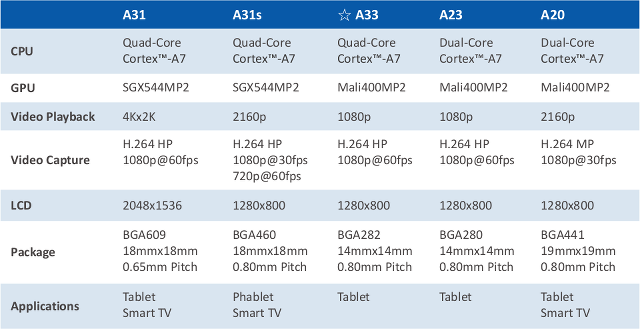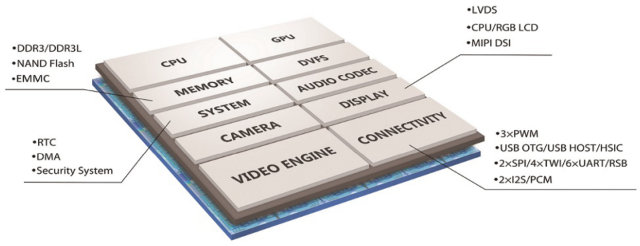Allwinner has just announced a new quad cortex ARM Cortex A7 SoC for entry-level Android tablets. AllWinner A33 shares many of the features of AllWinner A23 dual core Cortex A7, including an ARM Mali-400MP2 GPU, and provides pin-to-pin compatibility, with the main difference being the upgrade from two to four Cortex A7 cores.
The company has already disclosed the main specifications of their new SoC:
- CPU – Quad core ARM Cortex A7 with 256 KB L1 Cache, 512KB L2 cache
- GPU – ARM Mali-400MP2 with support for OpenGL ES 2.0/VG 1.1 standards
- Memory
- DDR3/DDR3L SDRAM controller
- 8-bit NAND/eMMC flash controller
- Video
- Decoding – 1080p60 video playback for MPEG-1/2, MPEG 4 SP/ASP GMC, H.263, H.264, WMV9/VC-1, VP8, and more
- Encoding – 1080p60 for H.264
- Complies with RTSP, HTTP, HLS, RTMP, MMS streaming protocols
- Supports OpenMAX API
- Display
- 1 to 4 lane MIPI DSI up to 1280×800
- RGB/CPU/LVDSLCD up to 1280×800
- Camera – Integrated paralell camera sensor interface with support for up to 5MP CMOS sensor, 8-bit YUV sensor
- Audio
- Integrated Hi-Fi audio codec
- 2x integrated differential analog mic amplifiers for headset and phone
- “Talking Standby Mode” for ultra low power consumption during voice calls
- USB – USB OTG. USB Host, and HSIC
- Other I/Os – 3x PWM, 2x SPI, 4x TWI (I2C), 6x UART/RSB
- Misc – RTC, Security system for DRM
- PMIC – AXP223 with support for 21-channel power output, 2.1A charging. Complies with USB 3.0 supply standard
AllWinner A33 will support Android 4.4 and above, so no official multi-OS support like other higher-end AllWinner SoCs.

You may have noticed AllWinner A33 is provided in a BGA282 package, and AllWinner A23 in a BGA280 package, so we’ve got two extra pins there… It could mean you can’t simply replace A23 by A33 on exiting designs, but it should be possible to make a new board that supports both A23 and A33, just like it is done today with AllWinner A10 and A20.
AllWinner A33 is sampling now, and the company expects the first commercially available tablet based on the platform to be available in July.

Jean-Luc started CNX Software in 2010 as a part-time endeavor, before quitting his job as a software engineering manager, and starting to write daily news, and reviews full time later in 2011.
Support CNX Software! Donate via cryptocurrencies, become a Patron on Patreon, or purchase goods on Amazon or Aliexpress






So this is then another SoC from Allvinner with CedarX VPU without open API, source code, or GPL compatible libraries?
@Harley
Maybe there’s another difference with a23: “openmax api”
@cnxsoft
A23 was deliverd with OpenMax as well.
The OpenMax interface is a “software only” solution. The hardware CedarX did not change, much, nor did the unclear license, versioning and ownership. They just added the OpenMax interface besides their own to make it more appealing to use with Andriod as they choose OpenMax as the standard interface for Video acceleration.
OpenMax has always been based as software Just like OpenGL, DirectX. They are software abstraction layers for hardware.
The “open source” solution for Cedar is the Cedarus project “sunxi-vdpau” where the vdpau interface was chosen for interaction with the hardware.
http://linux-sunxi.org/Cedrus
https://github.com/linux-sunxi/libvdpau-sunxi
https://www.youtube.com/watch?v=Fck_EDFcV1E
@Falcon1
But with an standard API, you should be able to integrate with whatever application you use, regardless whether the underlying library is open and closed source. I can see OpenMAX support is indeed claimed for A23 -> http://www.cnx-software.com/2013/11/04/allwinner-roadmap-until-2015-a23-a6x-a7x-a8x-and-a9x/
So I’m really confused…
AllWinner contacted me with price info:
“Reference Price:
Quad-core A33 SoC+ PMIC AXP223 ≈4.99USD
7″ Tablets powered by A33 ≈40USD ( A33, 7″,800*480, 1GB DDR3,8GB Flash)
7.85″ Tablets powered by A33≈ 45USD ( A33, 7.85″, 1024*768, 1GB DDR3, 8GB Flash)
8″ Tablets powered by A33 ≈ 50USD ( A33, 8″, 1280*800, 1GB DDR3, 8GB Flash)”
The question remains, when we will see a dev board supporting linux for Allwinner A33!?
@Gnichi Mohamed
Unlikely because there’s no HDMI output, so it would just be a board for LVDS or/and a MIPI interface. That’s also why there’s no A23 board.